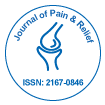The Effects of Opioids: Benefits and Risks
Received: 01-Jan-2025 / Manuscript No. jpar-25-163057 / Editor assigned: 03-Jan-2025 / PreQC No. jpar-25-163057(PQ) / Reviewed: 17-Jan-2025 / QC No. jpar-25-163057 / Revised: 22-Jan-2025 / Manuscript No. jpar-25-163057(R) / Published Date: 29-Jan-2025
Abstract
Opioids are a class of medications commonly used for pain management, offering significant relief for acute and chronic pain conditions. However, their use is accompanied by a range of effects, both beneficial and adverse. This article explores the pharmacological effects of opioids, including their analgesic properties, potential for addiction, and side effects. It discusses the mechanisms of action of opioids in the central nervous system and highlights the importance of balancing pain relief with the risks of dependence and overdose. Understanding the effects of opioids is crucial for healthcare providers to make informed decisions regarding pain management and to implement strategies that minimize risks while maximizing therapeutic benefits.
Keywords
Opioids; Pain management; Analgesia; Addiction; Dependence; Overdose; Central nervous system; Pharmacology; Side effects; Pain relief
Introduction
Opioids have been a cornerstone of pain management for decades, providing effective relief for patients suffering from acute and chronic pain. Derived from the opium poppy or synthesized in laboratories, opioids interact with specific receptors in the brain and spinal cord to reduce the perception of pain. While they are highly effective in managing pain, the use of opioids is fraught with challenges, including the potential for addiction, tolerance, and overdose. As the opioid crisis continues to impact public health, it is essential to understand both the therapeutic effects and the risks associated with opioid use [1].
Description
Opioids exert their effects primarily by binding to mu, delta, and kappa opioid receptors in the central nervous system (CNS). The activation of these receptors leads to a cascade of biochemical events that result in analgesia, sedation, and euphoria. Commonly prescribed opioids include morphine, oxycodone, hydrocodone, and fentanyl, each varying in potency and duration of action. The analgesic effects of opioids make them particularly useful for managing severe pain, such as that experienced after surgery or due to cancer. However, the benefits of opioids come with significant risks. Tolerance can develop with prolonged use, requiring higher doses to achieve the same level of pain relief. Additionally, opioids can cause a range of side effects, including constipation, respiratory depression, nausea, and sedation. The potential for addiction is one of the most concerning aspects of opioid use. Opioids can lead to physical dependence, where the body adapts to the drug, resulting in withdrawal symptoms when it is discontinued. Psychological dependence can also occur, characterized by cravings and compulsive drug-seeking behaviour [2-4].
Discussion
The opioid crisis has highlighted the need for careful prescribing practices and patient education regarding the risks associated with opioid use. Healthcare providers must weigh the benefits of opioid therapy against the potential for addiction and overdose. Strategies such as prescribing the lowest effective dose for the shortest duration, utilizing non-opioid pain management alternatives, and closely monitoring patients can help mitigate risks. Recent initiatives have focused on improving opioid prescribing guidelines and increasing access to addiction treatment services. Additionally, the development of abuse-deterrent formulations aims to reduce the potential for misuse while still providing effective pain relief. Despite the challenges, opioids remain an essential tool in pain management for many patients. Ongoing research into the mechanisms of opioid action and the development of new analgesics may provide safer alternatives in the future [5-7].
Conclusion
Opioids play a critical role in the management of pain, offering significant benefits for patients suffering from acute and chronic conditions. However, their use is accompanied by substantial risks, including addiction, tolerance, and overdose. A comprehensive understanding of the effects of opioids is essential for healthcare providers to make informed decisions regarding pain management. By implementing strategies to minimize risks and enhance patient education, the therapeutic benefits of opioids can be maximized while safeguarding against their potential harms. As the landscape of pain management continues to evolve, ongoing research and responsible prescribing practices will be vital in addressing the challenges posed by opioid use.
References
- Carninci P, Kasukawa T, Katayama S, Gough J, Frith MC, et al. (2005) . Science 309: 1559-1563.
- Harrow J, Frankish A, Gonzalez JM, Tapanari E, Diekhans M, et al. (2012) Genome Res 22: 1760-1774.
- García-Padilla C, Aránega A, Franco D (2018) . AIMS Genet 5: 124-140.
- Expósito-Villén A, Aránega AE, Franco D (2018) . Non-Coding RNA 4:1.
- Shi X, Sun M, Liu H, Yao Y, Song Y (2013) . Cancer Lett 339: 159-166.
- Statello L, Guo CJ, Chen LL, Huarte M (2021) . Nat Rev Mol Cell Biol 22: 96-118.
- Scott MS, Ono M (2011) . 93: 1987-1992.
, ,
, ,
, ,
, ,
, ,
, ,
Citation: Arif S (2025) The Effects of Opioids: Benefits and Risks. J Pain Relief 14: 707.
Copyright: © 2025 Arif S. This is an open-access article distributed under the terms of the Creative Commons Attribution License, which permits unrestricted use, distribution, and reproduction in any medium, provided the original author and source are credited.
Share This Article
Recommended Conferences
Toronto, Canada
Recommended Journals
51ºÚÁϳԹÏÍø Journals
Article Usage
- Total views: 51
- [From(publication date): 0-0 - Apr 28, 2025]
- Breakdown by view type
- HTML page views: 33
- PDF downloads: 18
